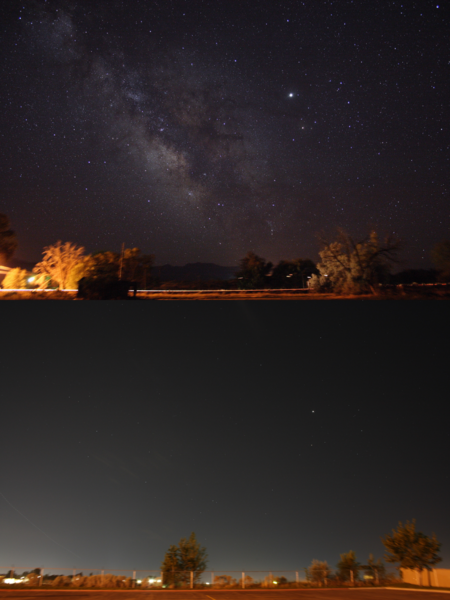Drag your bones toward more Halloween-themed citizen science.

Growing up in the last green valley, I didn’t think too much about light pollution. We always brought flashlights trick-or-treating, and I can remember being afraid to go outside after sunset for fear of what could be hiding in the dark; we could always see the stars. After living in Boston, however, I realize that many people don’t get to experience this level of darkness, as light pollution in most urban areas is so intense that the constellations are obscured.
To help citizen scientists measure the light pollution around the globe, DDQ has developed an app called Dark Sky Meter. The app uses the camera of an iphone to measure sky quality, which is a meter for the darkness of the night sky. The app correlates the data from thousands of submissions world-wide and places them on a map. As Norbert Schmidt, the primary programmer describes, “We are creating a map of light pollution profiles, a high resolution map.”
As an amateur astronomer, Schmidt’s original motivation for designing the app was to help fellow star-gazers find the best places to set up their observations. He notes, “We don’t see stars anymore, any galaxies, or the milky way in city centers.” By creating an up to date database of the darkest areas, he and the DDQ team hope to create a “living map” of the best observation areas.
 The data has more applications than astronomy too – scientists can use it to study the impact of light pollution on both humans and animals in the affected areas. Light pollution has been shown to disturb sleep quality and sleep cycles in humans, as well as disrupt migration patterns in other animals such as birds. More research needs to be done to fully understand these effects, and Dark Sky Meter can provide the necessary sky quality information to the scientists. The International Dark Sky Association, an organization dedicated to spreading awareness about light pollution, worked closely in developing the app with the goal of increasing the public’s knowledge of the problem and crowd-sourcing this valuable data for future studies.
The data has more applications than astronomy too – scientists can use it to study the impact of light pollution on both humans and animals in the affected areas. Light pollution has been shown to disturb sleep quality and sleep cycles in humans, as well as disrupt migration patterns in other animals such as birds. More research needs to be done to fully understand these effects, and Dark Sky Meter can provide the necessary sky quality information to the scientists. The International Dark Sky Association, an organization dedicated to spreading awareness about light pollution, worked closely in developing the app with the goal of increasing the public’s knowledge of the problem and crowd-sourcing this valuable data for future studies.
So this Halloween, if you’re not too scared of the dark, get outside and measure the sky quality in your neighborhood. Your submission will contribute to the work of astronomers and scientists around the globe.
References: International Dark Sky Association
Images: Top – wikipedia via jpstanley. Bottom – DDQ
______________________________________________________________________________________________________________
Emily Lewis is a PhD candidate in chemistry at Tufts University, where she analyzes industrially important catalysts on the nanoscale. She received her BS and MS degrees from Northeastern University, and her thesis work examined fuel cell catalysts under real operating conditions. She loves learning about energy and the environment, exploring science communication, and investigating the intersection of these topics with the policy world. When she’s not writing or in the lab, you’ll probably spot Emily at the summit of one of the White Mountains in NH. Follow her: @lewisbase, emilyannelewis.com.

